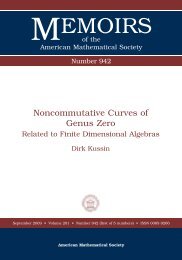University of Paderborn Department of Mathematics Diploma Thesis ...
University of Paderborn Department of Mathematics Diploma Thesis ...
University of Paderborn Department of Mathematics Diploma Thesis ...
Create successful ePaper yourself
Turn your PDF publications into a flip-book with our unique Google optimized e-Paper software.
32 CHAPTER 2. STABLE IDEALSfor all j ≥ ˜d, which showsh R/I (j + 1) = h R/I (j) 〈j〉 = h R/J (j) 〈j〉 = h R/J (j + 1)for all j ≥ ˜d. Hence, we obtain h R/I (j) = h R/J (j) for all j ≥ 0, which proves (i).(ii) We have to show that we can always find a monomial m as described in step (2)(ii)<strong>of</strong> the algorithm. Assume, at some stage <strong>of</strong> computation we cannot find a monomial m<strong>of</strong> degree d in ¯R. Let I := (M) denote the ideal generated by the monomials, which arecontained in M at this time. We know that the numerator <strong>of</strong> H(t) still contains t d . Sincewe know from (i) that h I (d) ≤ h J (d), we must have h I (d) < h J (d). Hence, there is atleast one more monomial <strong>of</strong> degree d in J than in I. Since we cannot find a monomialm ∈ ¯R = K[x 0 , . . . , x n−1 ], there is at least one monomial generator <strong>of</strong> J containing thevariable x n , which is a contradiction to the assumption that J is saturated and stable.(iii) At each stage <strong>of</strong> computation, the monomial m chosen in step (2)(ii) is the largestmonomial <strong>of</strong> ¯R, which is not yet contained in the ideal I. Hence, I is a lexicographic ideal<strong>of</strong> ¯R at each stage <strong>of</strong> computation, which shows that L H is lexicographic in ¯R. Becauseany division and multiplication by a monomial generator m <strong>of</strong> L H in the sense <strong>of</strong> Definition2.8 produces a monomial m ′ with m ′ > m in lexicographic order, we conclude that L His stable. In step (2)(ii), we only choose monomials in ¯R not containing the variable x n .Hence, by Theorem 2.13, L H is saturated.(iv) The algorithm terminates, if we have g(t) = 1. Thus, one minus the sum <strong>of</strong> allpolynomials (1 − t) l · t d added to g(t) in step (2)(iii) equals the numerator <strong>of</strong> the Hilbertseries H R/J (t), which shows H R/J (t) = H R/LH (t).Note that it is necessary, to assume that the Hilbert series H(t) <strong>of</strong> Theorem 2.21 belongsto R/J for J ⊂ R a saturated (stable) ideal. Otherwise, we could choose the idealJ := (x 2 0, x 0 x 1 , x 0 x 2 , x 2 1, x 1 x 2 , x 2 2) ⊂ R := K[x 0 , x 1 , x 2 ], which is generated by all monomialsin x 0 , x 1 , x 2 <strong>of</strong> degree 2. Hence, the numerator <strong>of</strong> the Hilbert series H R/J (t) will contain−6t 2 and we would have to choose 6 monomials in ¯R = K[x 0 , x 1 ] to eliminate the term,but there are only three monomials <strong>of</strong> degree 2 in K[x 0 , x 1 ], which can be included intothe set M in the algorithm. In this case the algorithm cannot give a correct result.We will look at two examples, to see how the algorithm works in detail.Example 2.23. Let R := K[x 0 , x 1 , x 2 ] and I := (x 2 0, x 0 x 1 , x 2 1). The (non reduced) Hilbertseries <strong>of</strong> R/I is given by H(t) = 1 − 3t2 + 2t 3(1 − t) 3 . If the algorithm is correct, it should returnthe ideal L H = I, for I is a saturated stable ideal fulfilling the conditions <strong>of</strong> Theorem 2.21.We will now follow the steps <strong>of</strong> the algorithm:• At the start, we have M := ∅ and d = 2. The first monomial in lexicographic ordersuch that the ideal generated by M is a stable ideal is m = x 2 0. Thus,M := M ∪ {x 2 0} = {x 2 0},
















